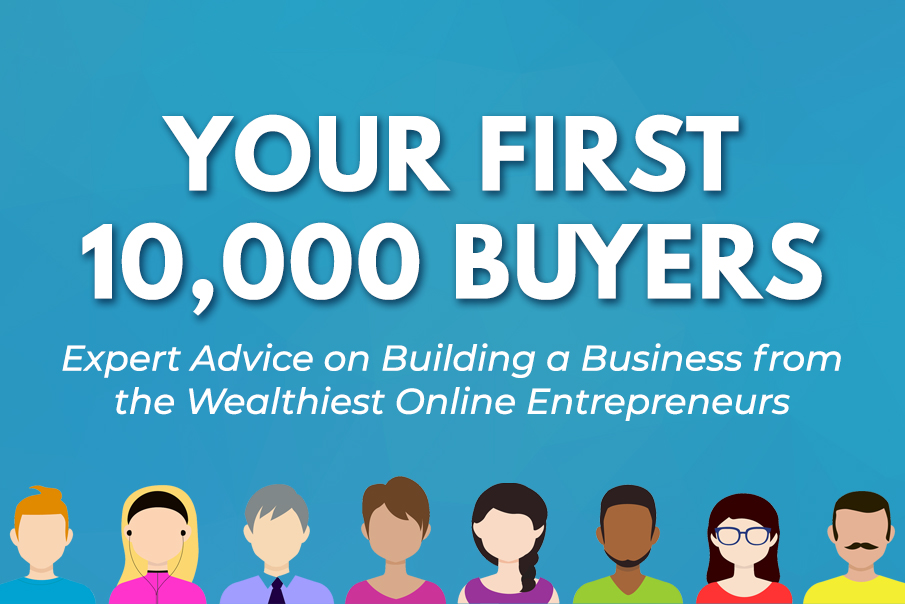Expert Advice on Building a Business from the Wealthiest Online Entrepreneurs
People say that getting your first buyer is the most important milestone in your entrepreneurial journey.
I disagree.
The real milestone that matters is not your first, but your 10,000th buyer.
10,000 buyers for a $1 product means a year’s college tuition.
10,000 buyers for a $10 product means a six-figure income.
10,000 buyers for a $100 product means life-altering money.
You get the idea. A buyer (or three) might be a fluke. 10,000 buyers is life changing.
But how do you get your first 10,000 buyers?
Simple: by following people who’ve already done that, and much more.
The Secret Principle of Entrepreneurial Success
I’ll let you in on a big secret.
It’s the secret behind the success of all the rich and famous people in the world, from Steve Jobs to Seth Godin.
Ready?
Here it goes:
“You can succeed at anything in the world if you can find the right people to follow.”
I know this sounds far too simple. Maybe even a bit hokey, but it’s true: successful people build their success by following already successful people.
This is how Jony Ive built his career (by following Dieter Rams), how Larry Page picked up his business chops (by following Eric Schmidt), and how Mark Zuckerberg learned to think big (by following Steve Jobs).
To just give you an example of the value successful people place on mentorship, Jeff Bezos runs a mentorship program where a top executive gets to “shadow” Bezos to all his meetings, lunches and travels for a year or two. It’s the “follow the successful” principle amped to an astonishing degree.
To Get 10,000 Buyers, Learn from People Who Have 1,000,000 Buyers
Pop quiz: if you wanted to build a sports car, what would you do?
A – Ask a dude named Enzo Ferrari
B – Figure things out yourself and create something truly “innovative”
You’d obviously choose option A, right?
Yet, when it comes to online entrepreneurship, so many people choose the latter path. Instead of following successful people who’ve already sold hundreds of thousands of products, they try to reinvent the wheel and come up with something original and innovative.
Except that to truly innovate, you have to first master the mundane.
This is what I believe you must do if you want to get your first 10,000 buyers: follow people who have 1,000,000 buyers. Figure out how they closed their first deals, how they deliver value, and what makes their business tick.
To make your job easier, I’ve compiled advice some of the best advice from 10 of the world’s wealthiest entrepreneurs on getting your first 10,000 buyers.
Lessons from Your Virtual Mentors
The people on this list come from a wide range of backgrounds. Some of them are writers. Some are marketers. Some do SEO, some do social media.
They all have one thing in common: they’ve done exceptionally well in their business life.
Here’s what they have to say about building a business and getting your first 10,000 buyers:
1. Neil Patel: Help the Right People
You know him as the founder of Quicksprout, KISSMerics, CrazyEgg, and HelloBar.
He’s kind of a big deal. And he’s all over the internet, writing guest posts on SearchEngineLand, etc. ,etc.
In founding four businesses, Neil has sold millions of dollars of products. This includes info-products as well as SaaS tools that start at $200/month.
So how did Neil get his first customers?
Through cold email outreach.
Here’s an email he sent to Michael Moritz, Chairman of Sequoia Capital and a man worth just shy of $3B.

He sent this email way back in 2007 when he was still in college and things like user-experience and conversion rate optimization were largely niche nerd hobbies.
Neil wasn’t able to close a deal (in his own words, he wanted “too much money”), but he used the same tactic to build a million dollar revenue business.
He adopted the same approach when he was building out his software businesses – CrazyEgg and KISSMetrics. As he recounts in this Disruptware podcast interview, Neil let potential customers use his software for free just to get them on board early.
So does this mean you should start spamming everyone in your email list about your offer?
Not quite.
The twist that makes manual outreach successful
Let’s take your average internet marketer struggling to sell spammy $39 Clickbank products on dubiously named websites.
Suppose your email lands in his inbox telling him how he can improve his site and make tens of thousands of more dollars.
(Of course, you mention that you can do it for him for “just” $5,000).
Do you think this marketer is going to stretch his already overextended credit and pay you the $5k to do it for him, or he’s just going to take your advice and (try) to implement it himself?
This is what Neil found out as well.
“When I used to target people who weren’t rich, they would just take my recommendations and implement them on their own”
The lesson?
Target only rich people.
“Millionaires, on the other hand, are more likely to offer you a job or a consulting gig.”
See, millionaires are busy. They don’t have enough time to figure things out on their own. They have the cash AND they understand the ROI of quality work – if spending $10,000 today makes them $100,000 over 2 years, it’s a worthwhile investment for them.
How to apply this to your business:
- Make a list of 10 successful people you can help make more money/save time/live a better life.
- Pitch them your ideas via email. Don’t hesitate to give away the entire farm in your email – it’s the execution that matters, after all.
- Offer to implement the ideas for them for a fee.
Bonus: Successful people have overflowing inboxes. You can drastically improve your chances of being noticed by doing something beyond an email – such as a Slideshare, a custom landing page, or even a video.
For example, here’s an email Bryan Harris of Videofruit sent HubSpot:

HubSpot called it the “best guest post pitch” they’ve ever received.
Bryan not only sent an email, but even included a demo of the final product.
Smart? You bet.
Other things you can learn from Neil
Invest in clothes. Like $162,301.42 worth of clothes.
Tools to help you get this done
- Yesware, to keep track of emails.
- Boomerang to reschedule emails.
- VoilaNorbert to figure out anyone’s email address.
2. Derek Halpern: Drafting your way to 10,000 buyers
You’ve probably seen Derek’s handsome mug all over the internet.
It’s definitely the first thing you see when you land on his wildly popular website, SocialTriggers.

But it’s not his good looks that got him featured on Entrepreneur, Forbes and Fast Company. It’s his ability to pull massive traffic numbers (Alexa rank: 19,884) and sell millions of dollars of products.
So how does he do it?
Drafting.
That’s a term from racing – when you ride closely behind someone to reduce wind resistance. It’s also called riding in someone’s “slipstream”.
In business, this means drafting behind your competitors and being where they are.
“Drafting is about hopping into your competitor’s slipstream. If they get featured somewhere, you try to get featured there too.”
Translated:
- Find bloggers/journalists etc. who’ve written about your competitors.
- Jump in and offer answers to questions and doubts raised in the article.
Here’s how this works in practice:
- Suppose you create incredible headphones but your competitor (with inferior headphones) gets all the press.
- You read the press reports and you notice that quite a few raise a few concerns about the headphones’ bass.
- You email the journalist/blogger and tell them about your recent post that answers all concerns about the bass.
Congratulations, you’ve now successfully drafted into your competitor’s slipstream. They did all the work of reaching out to bloggers and journalists and working with them to get a story out. You just jumped in and offered your own expertise, completely undercutting their work.
Since Derek is a super nice guy, he even has an email template to contact your target bloggers:
Hey Name,
I saw you wrote about [insert topic]. Well, I’ve got some [insert unique story angle] that answers the concerns you raised in your original article. Here’s the article:
[insert link to article here].
You’re busy but you’ll find this as the perfect answer to [insert the concern they raised].
– Derek
Why this technique works
This technique works because of two reasons:
- The ground work has already been done for you by your competitors. If a post about your competitor’s product got the publication 10,000 page views, you bet they would be interested in writing more about products in that category.
- Smart bloggers, writers and editors know that people are fundamentally tribal. They know that if they can position your product in opposition to your competitors, they’ll attract fans/haters of both products. This is why you can’t escape those Apple vs. Microsoft debates online – the manufactured controversy is too tantalizing for publishers.
Derek goes in-depth about this technique in this long (52 minutes and counting!) video he shot for Entrepreneur.com.
Other things you can learn from Derek
The Pareto Principle: success is 80% promotion, 20% creation.

That is, spend at least 80% of your time promoting your content, 20% writing it.
Tools to help you get this done:
- BuzzSumo.com – to figure out what’s the most popular content on your product/niche.
- FollowerWonk.com – to search Twitter bios and find the right bloggers/authors/editors.
- Good old Google search.
3. Ramit Sethi – Winning with Psychology and Data
Ramit Sethi is the author of the NYTimes Bestseller, “I Will Teach You to be Rich”. He’s been featured in Forbes magazine as a ‘money expert’ (right next to Warren Buffet). Over the years, he’s built up the ‘I Will Teach’ brand to cover everything from saving money and negotiating a raise to starting a business and getting your dream job.

For his flagship course – Zero to Launch – he charges $12,000 per student. And he has so many students that he has to routinely shut it down.
So how does Ramit make money?
Straight from the horse’s mouth:
“About 98 percent of my stuff is free, and then, occasionally, I will release a course. Usually, these courses take me a couple of years to develop, and then they tend to be pretty premium prices”
Before Ramit was a money guru, he was writing code and studying psychology at Stanford. And that’s pretty much formed the foundation of the IWT business: data and psychology.
According to Ramit, data helps you stand out from the crowd of me-too competitors:
“The beautiful part is that because so few people are doing this, if you do even a small amount—you completely stand out. You don’t need 25,000 data points. That’s ridiculous. It took me years to be able to get to that. If you have 20 qualitative responses to one survey question, that’s pretty informative.”
And psychology is what helps you be the best:
“IWT isn’t about money, or entrepreneurship, or even careers. In truth, IWT is about using psychology to live a Rich Life. The psychology, persuasion, and social influence lessons I learned at Stanford, applied in my life, and tested in my business. This is what I teach every day via my personal laboratory of IWT.”
How to apply this to your business
Data + psychology sounds super nice on paper, but you’re obviously wondering: how the heck do I apply it to my business?
Ramit has an answer for that as well.
In this post on getting your first freelancing clients, Ramit nails down the data + psychology approach.
Essentially, he says, you have to:
- Get inside your clients’ heads and truly understand what they want (the psychology part).
- Collect feedback on your business, your pitch, your ability to execute (the data part).
You can easily apply the same principles to virtually any business.
It’s not really rocket science, but it is a lot of spadework. Be prepared to spend hours meeting people in your target demographic to figure out what they want. Don’t assume that your pitch, your business or even you yourself will be liked or not – test it out in the wild and gather real data.
Other things you can learn from Ramit
“Don’t Underbid to Get Early Clients – It Hurts Your Pocketbook And Credibility.”
And if you ever need a pick-me-up, just head over to YourSurrogateAsianFather.com

Tools to help you get this done
- Google forms – to create surveys.
- Google Sheets – to gather all responses.
- Typeform – to create better surveys than Google Forms.
4. Noah Kagan: Validate Your Idea Before Building Anything
Noah Kagan is the founder of AppSumo and SumoMe. He also has the distinction of being employee #30 at Facebook and #4 at Mint.
Besides marketing, Noah also has a profound love for tacos.

Both AppSumo and SumoMe are now multi-million dollars a year businesses. Sure, Noah missed his $100M payday by getting fired from Facebook way before its IPO, but he’s bounced back and pretty much built a very large and enviable fortune through sheer marketing hustle.
His secret?
Start small, validate your idea and deliver exceptional value.
Start with really small potential customers and use them as your sales people once you’ve over-satisfied them for larger customers.
Noah followed this when he was building Payments for Facebook Games (Gambit). He then followed it when he built AppSumo, which was famously started for just $50.
Here’s why:
“All I’m going to suggest is that you start with a much simpler essence of your product over the course of a weekend, rather than wasting time building something for weeks… only to discover no one wants it.”
Which basically means that before you bet the farm on an idea, at least make sure that your target customers want it. Stay lean, build a simple, cheap prototype (‘MVP’ in startup speak), and release it on your target audience.
How to apply this to your business
This is essentially a three-step process:
- Find a profitable idea.
- Find a way to make a cheap prototype.
- Find a hungry audience who can test the prototype.
This sounds pretty hard, but it’s actually quite simple when you break it down.
- You can find profitable ideas on Amazon Top Sellers list by seeing what sells (something I’ve followed to sell 978 fiction books per day), by looking through frequent requests on Craigslist, and by generally being aware of what you see people using every day, and what they struggle with.
- You can build a cheap prototype by outsourcing it to coders from India or Romania on UpWork. If it’s a simple product, you might even be able to customize a WordPress theme for it (and save money in the process).
- To find if there’s a demand for the product, use tools like Google Trends to see search volume for it. Then use Google Search to find niche communities such as forums and sub-reddits to find people interested in the product. Pitch them your idea and see what they have to say.
This might be a lot of work, but it’s far better than wasting 1000+ hours building a product only to find that no one wants it.
Other things you can learn from Noah
When in doubt, use quant based marketing.
Tools that will help you follow Noah’s advice:
- Google Keyword Tool to see search volume for a product
- Google Search to find number of competitors in a market (more competitors = proven market).
- LaunchRock.com – to set up a pre-launch page (and collect emails).
5. Ryan Deiss – Teach Your Way to Success
Ryan Deiss is the hugely successful marketer behind DigitalMarketer.com. He is THE guy you want to turn to if you want to understand internet marketing.
Apart from making $1000 from every blog he starts (besides $6M from another blog about survival skills), Ryan has tons to teach you about getting traffic and building funnels.
The most important thing you can learn from Ryan, however, is this:
“The world does NOT need more information. Instead, what the world needs (and values) is a trusted authority who will organize and aggregate all the GOOD information that’s actually worth reading into one place.”
In other words, you need to STOP creating completely new content and instead, curate the best content on a topic that already exists.
And you need to do it consistently enough, and with enough focus on quality to be considered an ‘authority’.
Which is to say, you must become a respected teacher and not just a content creator.
You’ve already seen how effective this approach can be – Oprah built a billion dollar empire ‘curating’ people, so much so that the people she associates with get authority of their own.
This, in fact, is the strategy behind Ryan’s entire business model at Idea Incubator:
“Really, the centralizing thing is we’re looking to provide information and strategies for people who are actively looking to improve their lives. Whether it be financially or emotionally, getting more balance in their life. We’re out there offering solutions to people who are seeking answers.”
How to apply this advice to your business
In Ryan’s own words:
“So as crazy as it sounds, the first step to becoming a respected authority in your market isn’t to publish something new and amazing…
…the first step is to identify and associate with the most trusted, authoritative experts in your niche and then seek to aggregate and promote THEIR CONTENT in one place (i.e. your site)“
To do that, follow this process:
- Find at least 10-12 leading authorities in your niche.
- Find out what their best content is.
- Curate the best ideas from this content and wrap it in your own insight.
This isn’t really complicated – the best blogs online follow this model. The Buffer.com blog, for example, essentially curates marketing knowledge from all across the internet. Derek Halpern at SocialTriggers.com doesn’t actually do any psychological research of his own – he just finds what has already been researched, and he presents it in a better fashion.
In fact, even huge influencers such as Malcolm Gladwell follow this model.
You can get similar influence and authority by following in Ryan’s footsteps.
Tools to help you put Ryan’s advice into practice:
- BuzzSumo, for finding the most popular content on a niche.
- Google Scholar, for finding research papers to quote studies on your topic.
- LeadPages, for capturing leads that drop by your site.
- Drop, for creating autoresponder sequences for your leads.
6. Brian Clark: Just Get them to Read the First Sentence Read. Then Another…
Brian is the founder of CopyBlogger and the Rainmaker platform. Through Copyblogger,he has helped educate a generation of writers and copywriters. Even 9 years after founding it, the blog remains the gold standard for writing blogs online.
Oh, and all this has helped Copyblogger turn into a $7M/year business.
So what makes Brian Clark and Copyblogger tick?
Words.
As he says in this Mixergy interview:
“If people don’t want what your words in any medium, text, video, audio, what they’re conveying, you’re wasting your time. It really comes down to that.
We went from zero to seven million with just that (words)…So you can make a lot of money with just plain old fashioned words and I think I need to keep reminding people that”
Quoting legendary copywriter Joe Sugarman, Brian notes:
“Every element of copy has just one purpose — to get the first sentence read.”
So in a way, great copy is just a string of sentences that compel the reader to read the next one.
It’s as simple as that. And it can make you millions of dollars.
How to apply this to your business
The first rule of winning with words is to deliver value, and then to monetize that value. As Brian notes:
“If you can create free content, you can create premium content that people will pay for and that’s the way you get into business.”
The second rule is to engage the reader with each and every word you write. This means you must:
- Write a compelling headline.
- Follow that up with an engaging lede to keep readers interested.
- Focus on the benefits – tell readers what they’ll learn through your content.
- Deliver on the promise and offer compelling proof of every claim.
- Close with a flourish (and a strong CTA).
Now this is all high-level stuff. You’re obviously wondering: how can a beginner even begin to learn how to create great copy?
Do this:
- Read ‘Ogilvy on Advertising’. Then read it again. And again.
- Read Joe Sugarman’s ‘Advertising Secrets of the Written Word’.
- Follow this 30 minute exercise I outlined earlier. Do this every day for 10 years and you’re guaranteed to create wealth.
Tools to help you put Brian’s advice into practice
- Swiped.co – for doing my 30 minute copywriting exercise.
- Read-Able.com – for figuring out where your content stands on the readability scale (hint: the best copy reads at a 4th to 8th grader level).
- EMV Headline Analyzer – for checking your headlines’ “emotional quotient”.
- Word, Notepad, Google Docs, Scrivener, or any other tool you use to write.
All these entrepreneurs have been successful in fields as different as marketing, social media, copywriting and teaching. Yet, once you dig through their work, you start noticing patterns. Regardless of what they do, these entrepreneurs always:
- Focus on delivering value.
- Have mastered the art of communication, whether in words, images or video.
- Focus on helping the right people instead of building a “one size fits all” solution.
Follow their principles, and you’ll soon be on your way to 10,000 buyers yourself.




